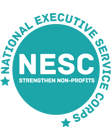Alternative Funding for Nonprofits
Strategies for a Changing Financial Landscape
As government funding recedes, nonprofits must rethink their revenue streams. To remain sustainable and mission-driven, nonprofits must diversify their revenue sources. NESC sees the Administration’s grant elimination policies as an opportunity to help our clients with the challenges of this rapidly changing environment. Below, we identify five approaches—social enterprise, fee-for-service models, corporate partnerships, crowdfunding, and individual donor cultivation—that provide viable alternatives to traditional government grant funding. The steps outlined here are examples designed to help nonprofit boards and leaders build a sustainable financial future.

1. Social Enterprise
Overview:
A social enterprise applies business principles to generate revenue that supports the mission. For example, a community health nonprofit might operate a small café or wellness program, reinvesting profits into its core services.
Key Resources:
- Stanford Social Innovation Review – Social Enterprise in the Public Interest
- Harvard Business Review – The New Rules of Corporate Partnerships
Implementation Steps:
- Conduct a Feasibility Study: Assess market demand and alignment with your mission.
- Launch a Pilot Program: Start small to test the model without overextending resources.
- Develop a Business Plan: Include detailed financial projections and break-even analysis.
- Establish Oversight: Form a committee—including board members with business experience—to monitor progress.

2. Fee-for-Service Models
Overview:
Fee-for-service models involve charging for existing programs or services previously embedded in core offerings. This earned income approach can reduce dependence on external grants while reinforcing an organization’s expertise.
Key Resources:
- National Council of Nonprofits – Earned Income Strategies for Nonprofits
- Nonprofit Management & Leadership Journal
Implementation Steps:
- Identify Core Competencies: Review current programs to find those that could be monetized.
- Perform a Cost Analysis: Ensure fees cover expenses while remaining competitive.
- Create a Marketing Plan: Clearly communicate the value of identified services to potential customers. Be mindful of existing customers’ expectations. Explain why.
- Measure Impact: Use metrics to monitor both financial performance and mission impact.

3. Corporate Partnerships
Overview:
Corporate partnerships bring together nonprofit missions with corporate social responsibility objectives. These partnerships can include funding, in-kind support, and volunteer resources.
Key Resources:
- Harvard Business Review – The New Rules of Corporate Partnerships
- Nonprofit Quarterly regularly features case studies of corporate-nonprofit collaborations.
Implementation Steps:
- Identify Aligned Corporations: Map out companies whose corporate social responsibilities (CSR) match your nonprofit’s mission.
- Develop a Partnership Proposal: Clearly outline mutual benefits and shared goals.
- Build Relationships: Foster regular communication and formalize agreements (mutual benefits and potential impacts).
- Report Impact: Provide transparent updates on outcomes to build trust and longevity.

4. Crowdfunding
Overview:
Crowdfunding leverages small contributions from a large audience, typically online, to fund specific projects or initiatives. A compelling narrative is key.
Key Resources:
- Forbes – How To Successfully Launch A Crowdfunding Campaign For Your Nonprofit
- Nonprofit Quarterly
Implementation Steps:
- Set Clear Goals: Define a specific project with a realistic funding target.
- Select a Platform: Choose an online platform (e.g., Kickstarter, GoFundMe, or CauseVox) that aligns with your audience.
- Craft Your Story: Develop engaging content (videos, images, and text) that conveys the project’s impact.
- Engage Your Network: Use email, social media, and community outreach to drive support.
- Follow Up: Keep donors informed of progress and results to build long-term engagement.

5. Individual Donor Cultivation and Major Gifts
Overview:
Cultivating relationships with individual donors—especially major gift prospects—creates a stable revenue stream. Personal engagement and consistent stewardship are essential.
Key Resources:
- BoardSource – Resources for Boards offers guidelines on best practices.
- Council for Advancement and Support of Education (CASE)
- Nonprofit Management & Leadership Journal supports the idea that personalized engagement and long-term relationship building are central to successful fundraising campaigns.
Implementation Steps:
- Segment Your Donor Base: Identify high-value prospects within your existing database.
- Develop a Personal Engagement Plan: Create tailored communication strategies, including exclusive events and personal updates.
- Leverage Board Networks: Engage board members in outreach and relationship building.
- Demonstrate Impact: Use regular reporting to show donors how their contributions are making a difference.
Strategic Guidance for Boards and Nonprofit Leaders
For a successful transition away from reliance on government funding, consider these overarching strategies:
- Strategic Planning: Organize retreats or strategy sessions with board members and key staff to evaluate current revenue sources and explore new opportunities.
- Capacity Building: Invest in training for staff and board members on new fundraising techniques. Useful resources are available from BoardSource and the National Council of Nonprofits.
- Dedicated Committees: Form subcommittees to focus on specific revenue streams such as social enterprise or corporate partnerships. Define clear milestones and metrics for each initiative.
- Pilot Programs: Start with small-scale projects to test new models before committing significant resources.
- Continuous Evaluation: Hold regular meetings to assess the performance of new funding strategies and adjust based on feedback and financial outcomes.
NESC has extensive experience helping organizations develop alternative revenue sources. We systematically analyze the opportunities and an organization’s ability to exploit them. We then work with the client to set realistic goals and create a detailed action plan to achieve those goals.
To schedule time to discuss your organization’s concerns, email sreis@nesc.org.


